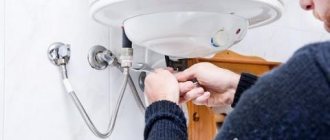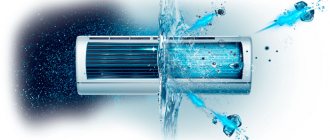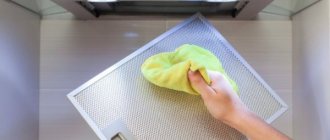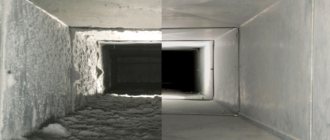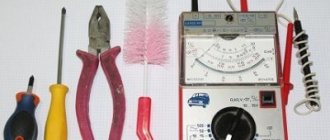In practice, many of us have encountered such a negative phenomenon as the formation of a thin layer of fatty plaque. Literally everything is covered with film: kitchen walls, furniture cabinets and other kitchen items. This negative phenomenon is especially intense when using a gas stove, because even high-quality gas, when burned, itself releases particles of greasy soot, which mainly create this problem in the kitchen. This forces us to frequently carry out general cleaning and thoroughly clean almost every kitchen item from grease deposits. To a large extent, good ventilation of the kitchen helps resolve this issue.
How to clean a home hood
It is difficult to imagine a modern kitchen without the presence of hoods, the variety of which (both in design and in functionality) has a wide range. The operation of kitchen hoods is based on two principles: removal of contaminated air through the ventilation duct and its complete recirculation in the kitchen space. The so-called intermediate principle is also used, when both exhaust and partial air recirculation are used. If in the first case, only a grease filter is used for normal operation of the hood, then for the second and third options a carbon filter is also needed, which cleans the air from particles that give the air an “odor”. In the vast majority of cases, the principle of full exhaustion through the ventilation system is used; it is no coincidence that almost all manufacturers of kitchen hoods install only grease filters on them, although the installation of carbon filters is also structurally provided for.
And so, we settled on the fact that a kitchen hood is designed to purify the air in the kitchen not only from odors arising during cooking, but also to remove the smallest particles of fat and soot. The hood will cope with this task perfectly as long as the grease filter allows the purified air to pass through it without any hindrance. The fact that the filter is almost completely clogged will be signaled by the device itself: the electric motor will work under a higher load, therefore its operation noise will increase, vibration may appear, air circulation will significantly deteriorate, the filter, especially in heavy load mode, will bend in an arc, trying to retract inside the hood. It is, in principle, possible to remove the filters and continue operating the hood without them, but this is not entirely safe, since uncleaned fats can damage the electric motor and other main components, and it can completely fail.
To prevent this from happening to your hood, you need to constantly look after it, thoroughly wash the grease filter once every 2-3 months, and if you frequently prepare homemade meals or use a gas stove for a long time, this operation must be carried out much more often, at least once a month.
Important: with systematic cleaning of the filter, the grease deposits that settle on it will not have time to become old, and it can be easily washed even with a regular soap solution.
Preparatory stage
Before you start cleaning the hood, study the device passport and determine the elements that need to be dismantled . Grease filters can be disposable or reusable.
Disposable models are made of acrylic, padding polyester - the products cannot be cleaned, they must be replaced with new ones when they become dirty.
Clear the working area of the stove from unnecessary objects, prepare a place for removable parts and disconnect the device from the power supply.
How to disassemble?
- Remove the grease gratings (they are attached to the main structure with bolts and clamps. In some cases, to remove the filters, you will need to remove the decorative strip).
- Hoods without an air duct are equipped with a carbon filter; this must also be removed and, if dirty, replaced.
- Disconnect the pipe that discharges exhaust air into the ventilation shaft, remove the air filter, if equipped.
Determine the degree of contamination of the device box and removable parts, select the optimal method for cleaning the device.
How to clean hood filters
Based on their functional characteristics, grease-catching filters are divided into reusable and disposable. Reusable filters are made of several layers of fine mesh (mostly aluminum, but stainless steel or galvanized can also be used), so if used correctly, they can serve without replacement throughout the entire life of the hood. The basis of disposable filters are microporous synthetic materials, their name speaks for itself: they cannot be cleaned (washed); when they become dirty, they simply need to be changed.
In almost all hoods, grease filters can be easily removed, since they are secured mainly with clips in the grooves. However, when disassembling for the first time, it is recommended that you carefully read this part of the hood’s operating instructions in order to be completely sure that the actions performed are correct.
How to clean the hood grate in the kitchen. When starting to clean the grease filter , you must first find out what material it is made of (aluminium, stainless steel, galvanized), as this is necessary for the correct selection of the detergents necessary for cleaning. For example, sulfuric, hydrochloric and oxalic acids have a detrimental effect on aluminum, this can be especially evident on aluminum foil, on stainless steel - chlorine, and on galvanized surface the protective layer is easily damaged by abrasive materials, which will lead to their further increased corrosion and destruction. Therefore, you need to choose detergents containing aggressive components for cleaning, taking these features into account.
Attention to the body
First of all, you should keep the outer surfaces of the kitchen hood in order . The housings of such equipment are cleaned using sponges, napkins and soapy water. If metal is used in the design, avoid using cleaning powders, pastes and other abrasives. In terms of composition, it is better to take a neutral cleaning agent - it is both universal and effective. The action of strong acids and alkalis will lead to the formation of a fine network of cracks, stains and scratches, which are subsequently difficult to remove.
The optimal solution is to use gel-like preparations designed for cleaning metal. They carefully clean the surface and form a protective, dust-repellent layer , although the purchase will be more expensive. Similar compositions are produced by the brands Electrolux, Sanita, Indesit. On average, the price is 300 rubles.
After cleaning, all surfaces must be wiped dry. Additional gloss is achieved by polishing, for which it is better to take suede or microfiber. Plastic and enamel coatings on cases are not so capricious, but they also do not like the effects of strong chemicals.
Other recommendations are as follows:
- Wash glass panels using simple products designed for crumpling glass and mirrors. They are easy to spray on the surface and remove with a paper towel or napkin. Stains are removed using microfiber;
- if the case contains elements made of natural wood, wipe off the dust with a dry cloth and periodically treat it with polish or wax.
To reduce all cleaning and maintenance operations to a minimum, when choosing equipment you should pay attention to models with a special protective layer. There are no water stains or drops left on such cases .
The buttons located on the external panel also love to accumulate dust. But getting rid of such deposits is not as easy as it seems. Wipe all controls with a soft cloth pre-treated with detergent. Before any actions, the device must be disconnected from the network.
How hoods are connected to the power supply and ventilation
Methods for cleaning the grease filter:
With regular cleaning, fat and soot from burnt gas do not have time to tightly clog all the filter holes and become thoroughly aged (petrified under the influence of hot temperature), so it is enough to simply wash it in soapy water . To do this, dissolve soap (preferably laundry soap) or dishwashing detergent, which also actively breaks down fats, in water, then place it in this solution. After some time, when the accumulated dirt has liquefied, make several rinsing movements with the filter in a container with soapy water, and then rinse under a strong stream of clean water.
A grease filter that is not very dirty can also be thoroughly washed in the dishwasher . To do this, the filter cassette must be installed vertically and the machine must be turned on in normal mode. It is true that washing dishes, especially heavily soiled ones, is undesirable, since the filter meshes can be clogged with food residues, which will then be extremely difficult to wash.
When cleaning, you need to use available means (not hard brushes, rags, soft sponges) very carefully; using excessive force can damage the filter mesh. After this, the filter must be dried and put back in place.
How to clean the grates of the hood from grease if the filter meshes are completely clogged with layers of dirt, which has also become “petrified” from time and exposure to hot air. Simple flushing will not help; more radical measures must be taken. In this case, the grease from the hood filter can be cleaned using:
- Baking soda. It is necessary to select a container suitable in size for placing the filter, make a soda solution (at the rate of 1 - 2 tablespoons per 1 liter, gradually pour into boiling water), boil the filter in the soda solution for half an hour. The boiling time, as well as the concentration of the solution, can be changed depending on the degree of contamination of the filter. After the solution has cooled slightly, remove the filter and rinse thoroughly with running water.
- Ammonia. If it was not possible to completely clean it with soda, an aqueous solution of ammonia (2 teaspoons per liter of water) will help. Place the filter cassette in this solution for a quarter of an hour (ammonia actively breaks down fats), then rinse well with clean water.
- Vinegar essence. Effectively softens and dissolves old fat deposits. You need to thoroughly wet the filter mesh with essence, repeat this procedure several times if necessary, then rinse the filter cassette in clean hot water, rinse in soapy water, again in clean water and dry.
- Lemon acid. Place the filter cassette in a solution of citric acid (about 1 tablespoon per liter of water, but the concentration can be varied), after 15 - 20 minutes visually inspect the filter, if cleaning is successful, this will be clearly visible on the brightened surface of the aluminum. Wash the remaining fat first with a soapy solution, and then under strong pressure of clean water and dry. The filter is ready to be reinstalled. You can also use squeezed lemon juice for this purpose. To do this, you need to generously soak the contaminated mesh with lemon juice several times, and when the fatty deposits soften, wash them with water in the same order.
- Salt. Place the grease filter in a well-concentrated hot saline solution (1 - 2 tablespoons of salt per liter of water) for about 15 - 20 minutes, the salt perfectly corrodes the fat, then rinse under pressure with clean water.
Important: when preparing a soda solution, you cannot pour soda into boiling water in large portions, since the resulting bubble foam can cause a burn injury.
If the so-called traditional methods are unsuccessful, and the filters cannot be completely cleaned with their help, it’s time to use special chemicals . Currently, there are several special products on the market designed for cleaning filters. For example, Pyramida has good cleaning properties for grease filters with aluminum mesh (foil). It comes in the form of a spray, which simplifies the work. Simply spray the product onto the surface to be cleaned and rinse with water after a while. Does not react with aluminum. Features of its use are described in the instructions.
Disposable grease filters are produced on non-woven, padding polyester, acrylic or other synthetic microporous fabric base. Their name corresponds to the actual state of affairs, since when they become dirty, they cannot be cleaned (washed) and need to be replaced with new filters. In some sources you can find a statement that acrylic fabric on filters can be washed, but it must be taken into account that the air throughput is almost halved, so the hood will work under heavy load with this cleaning method.
After cleaning the grease filters, the cassettes must be replaced and secured securely. After this, you need to check the operation of the kitchen hood; if there are no unusual noises or vibrations, it means that it is assembled correctly and can be used further for its intended purpose.
Replacement instructions
As we found out above, disposable fat, combined and carbon cassettes cannot be regenerated by washing or rinsing. A contaminated element should be replaced if the following signs are detected:
- the indicator mark or the inscription on the thin grease filter, applied by the manufacturer, has changed color (usually turns red);
- the thrust has decreased significantly, the noise of the fan has noticeably increased;
- The carbon cartridge has expired;
- Some brands of hoods are equipped with differential pressure sensors, which indicate that the filter fabric or carbon cassette is completely clogged.
To remove the outer fat pad, simply unlock the 2 latches located at the edges (some models use one lock)
Attempts to wash a clogged disposable filter have, of course, been made by many users. The result is negative; it is impossible to remove absorbed fat from the fibers. Washed synthetic filler gets clogged up again quite quickly.
First you need to buy an air purification element for a specific hood. It is better to give preference to original filters of the same brand as your household appliances. In other cases, the manufacturer does not play a special role. If you cannot find a product of the required size, take a universal grease-absorbing filter - it fits most exhaust devices.
The universal aluminum mesh can be cut to the desired size and placed in an old frame
How to remove and install a new filter that captures grease vapors:
- Disconnect the device from the household power supply by unplugging the plug from the socket. It’s a good idea to be careful – during disassembly of some models you may accidentally hit the fan start button.
- Pull the built-in panel towards you until it stops.
- At the bottom, find the latches or plastic clips that hold the frame with the filter insert. Unlock them and remove the part.
- Disconnect the used filter and install a fresh one. The frame should be pre-washed with kitchen detergent and dried. Let's watch the replacement procedure in the video:
Cassettes filled with activated carbon are usually located behind the grease trap. To get to the carbon filter, the latter must be removed. The cartridge itself is secured with clamps or a Phillips screwdriver.
Before servicing a wall-mounted tilting hood, fold down the front protective shield. How to install a carbon filter on a similar household appliance is shown in a short video:
Charcoal filter cleaning
Carbon filters are mainly used in indoor air recirculation systems. They are designed to clean the air from microscopic particles that give it an odor color. The cleaning base in the filter is activated carbon. To extend the life of the carbon filter, it is necessary not to turn off the hood immediately after finishing cooking. Let it run for another 5 - 7 minutes in idle mode so that the activated carbon dries. When wet, it cakes quickly and the cleansing effect is lost.
By constantly keeping the air purification filters clean, you will extend the life of your kitchen hood and ensure its flawless operation.
Some simple tips
- Cleaning the filters after each cooking will help keep the grates clean. For regular use, regular dish detergent is suitable.
- You should not rub the thin surface of the grease-catching parts of the hood with brushes with metal bristles or wire wool - the presence of scratches on the product will contribute to additional accumulation of grease. Products with coarse abrasive particles are also not suitable for cleaning.
- Grease grates can be washed using products designed to remove dirt from the surface of gas stoves.
Was this article helpful?
Yes, of course! No, not at all!
General washing of the kitchen hood body and all components of the product must be done at least once a quarter.
Proper and regular care of the device will ensure uninterrupted operation and long service life of the device and prevent the appearance of dirt on the walls and interior items of the kitchen.
Exhaust fans
Powerful lamps become very hot, causing the air to become dry, which has a detrimental effect on the development of plants. Exhaust fans are used to remove heated dry air, as well as to bring fresh air into the room with plants. It makes sense to install them in the upper part of the room, because warm air, according to the laws of physics, rises.
To determine the approximate required fan power, let's turn to a simple formula: divide the lighting power in watts by 2 - we get the approximate number of cubic meters of air that the desired fan should blow out in 1 hour. To the obtained value we add 20% (power spent if a carbon filter is connected). In practice it looks like this:
400:2=200
200+20%=240
Answer: 240 m3/h.
If there are several light sources (DNAT 400 watt + ESL 125 watt + OSRAM Fluora 36 watt (2 pcs)):
Application in industrial premises
Clean air is necessary not only at home, but also at work. The environmental situation at the location of the enterprise depends on this. In production facilities, main compressed air filters are used, which have a large throughput and a high degree of purification. Industrial filters consist of fibers distributed in such a way that dirt particles accumulate as they pass through their layers. Cleaning devices used in the industrial sector can be divided into 2 types:
- preliminary – deep electrostatic and dry fine fiber;
- mesh - equipped with irrigation and capable of self-cleaning.
To normalize the operation of the ventilation system in industrial premises, a special filter and air pressure regulator is installed to lower the air pressure in the line and maintain it in a certain range.
The use of activated carbon filters is very extensive, since human health completely depends on the cleanliness of the air and the sorbing properties are undeniable. Even a car will not move without oxygen purified to the proper level. Dust and harmful gases are constantly floating in the air, so you shouldn’t skimp on your own health and install a carbon air filter. Not only the kitchen needs an exhaust device; any room deserves an air filter for an apartment or a private house.
https://youtube.com/watch?v=1N6oAhVpreY
Grille upgrade
The purpose of the action is to get rid of substances that settle on the fan parts and on the internal cavity of the hood. Stainless steel allows minimal grease droplets to pass through. For this reason, they can be delayed by fixing synthetic fiber inside. This can be a thin layer of foam rubber or tape padding polyester.
Secure it with thin wire. Such a component must be changed in accordance with a similar algorithm of actions when changing disposable filters. It is necessary to ensure that the fiber allows air flow to pass freely and does not form aerodynamic drag. This is unfavorable as it increases the load on the fan.
Combined elements
The product is made in 2 layers and has a flat shape. Activated carbon granules and synthetic fiber are placed inside it. The carbon layer is designed to neutralize harmful gases, and the synthetic padding promotes the effective absorption of fat. It is located below.
For hoods, a universal carbon filter for single-use hoods is suitable. It can be placed on replaceable flat-shaped filters. Subject to daily use, the service life of the product is no more than 3 months. Compared to fabric representatives, their price is about 30% more.
Frequently asked questions from buyers
It is believed that flow hoods remove 100% of unpleasant odors from the room, while recirculating hoods operating on carbon filters remove much less. In fact, it is impossible to remove all odors from the kitchen, since they spread very quickly to neighboring rooms.
The difference in performance between the two types of hoods is about 15-20%, that is, carbon filters clean the air quite well.
Exhaust equipment with new carbon filters, when used correctly, works in such a way that it protects wallpaper, tiles, ceilings and furniture from grease and other deposits
Many people do not want to constantly spend money on consumables, and instead of hoods with carbon filters, they buy a model with an air duct, believing that in the end it is cheaper.
To calculate the costs, you need to add the cost of cartridges to the cost of a recirculating hood - for 10 years, on average, you will need about 20 pieces. And to the price of a flow-through model, you must add the payment for materials (ducts, corrugations, fittings) and services for installing the air duct. Additionally, you should take into account the cost of the suspended structure, if it is required for camouflage. It remains to compare the results.
Also, in order to save money, enterprising owners of hoods, instead of the hard plastic cassettes recommended by the manufacturer, manage to put soft fabric filters into the housing, which cost 5 times less. This is a gross violation of the use of exhaust equipment.
Homemade and refurbished filters sharply reduce the performance of devices, and also do not provide any guarantee that the engine will function for the required period after such “protection”.
You can often hear the question - is it possible to use non-original cassettes and panels if there is no corresponding brand? Of course, it is possible, but under one condition - if they are suitable in composition and size. This is easy to do by carefully examining the packaging: the names of the models to which the cassette or cartridge fits are usually indicated directly on the front side.


